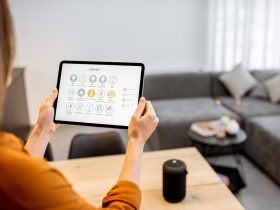Picture this: You kick off the day with a coffee made by your app-controlled coffee machine, your smartwatch monitors your fitness levels, and your home adjusts the heating automatically when you’re away. Welcome to the world of IoT devices — physical objects that are connected to each other via the internet to make life easier.
It all used to be science fiction, but now it’s long since become reality. IoT automation is opening up a whole new world of technical possibilities in the home, in healthcare, in farming, and in industry.
But just like every other technological revolution, there are risks. Unprotected IoT devices are prime targets for cyberattacks, which makes protecting them a top priority. Thankfully, tools such as Avira Free Security are on hand to defend your devices so you can use all the advantages of IoT securely.
What is an IoT device?
An IoT device is a networked, physical object that can collect, process, and forward data via sensors, software, and communication interfaces. IoT devices operate autonomously and efficiently — from household white goods like fridges which reorder food automatically to machines at production facilities that notify if they need servicing, preventing costly downtime.
IoT means Internet of Things — a technology that links physical objects, data, and people together. According to Statista, over 15 billion IoT devices have been in operation since 2023 — a number that’s expected to rocket to over 30 billion by 2030. These devices collect data from their physical environment, analyze it, and make decisions autonomously or transfer information to other systems.
What makes IoT devices so special?
IoT devices are special because they can communicate with other devices over the internet. The interconnected devices exchange information in real time and respond to it, enabling them to take care of tasks automatically and resolve issues before they occur.
As an example, a networked thermostat will constantly adjust the heating based on the room temperature and user’s preferences. IoT devices are now handy helpers beyond simply offering convenience.
One such practical example is predictive maintenance in industry. Sensors on machines continuously monitor operating parameters such as vibrations or temperatures. If something out of the ordinary is detected, the system can trigger a maintenance request automatically before the machine fails — saving time and outlay as well as making the workplace safer.
How do IoT devices work?
IoT devices operate based on a three-stage process: Collect, process, and transfer data. Sensors collect data such as temperature, humidity, or motion and convert it into digital signals. This information is transmitted wirelessly over networks such as Wi-Fi, Bluetooth, or cellular to a central platform. Here’s a breakdown of the process:
1. Data collection
Sensors are the heart of each IoT device. The measured data is converted into digital information which can then be analyzed or used to make decisions. Take a smart smoke detector for example, it’s always measuring particles in the air to detect signs of smoke.
2. Data processing:
At this stage, the collected data still needs to be processed. This is where two technologies come into play: Edge computing and cloud computing.
In the case of edge computing, the data is analyzed directly on the device or near the sensor, which is critical for applications where a rapid response is needed. For example, if a self-driving car detects an obstacle using its special sensors, it will make a lightning-fast decision without needing to first send the information to a data center.
By contrast, in the case of cloud computing the data is transferred to a central server where it can be analyzed in depth and stored. This is ideal for applications that collect vast amounts of data and analyze long-term trends, such as in farming or healthcare.
To illustrate the point, here’s an example from farming: Sensors measure soil moisture levels and send the data to the cloud. If the moisture level drops below a critical threshold, the system turns on the irrigation system automatically.
3. Communication:
IoT devices’ ability to communicate with other devices and systems is their hallmark — whether that’s over networks such as Wi-Fi, Bluetooth, or cellular.
Communication protocols like Zigbee, Z-Wave, and LoRa allow the devices to communicate with each other reliably and independently of the device manufacturer. This allows them to be used universally in a home, factory, or in the field.
Take a smart thermostat, for instance. It can communicate with window and door sensors so if you leave a window open, the thermostat is notified and turns off the heating to save energy. You can also use an app to control the thermostat and adjust its settings even when on the go.
When and where are IoT devices used?
There are now so many different types of IoT device that they impact almost every area of our life and work. Let’s look at some of the key areas of application:
- Smart homes and wearables: IoT devices such as smart thermostats, lighting systems, and wearables (like smartwatches and fitness trackers) have long since become mainstream in smart homes. They make life easier and allow you to keep track of your health.
- Industry 4.0: In industry, IoT devices can automate processes. They can also act as the eyes and ears of a system in the form of sensors which monitor production processes for predictive maintenance, helping to reduce downtime.
- Smart grids: In the energy industry, smart networks monitor power consumption and optimize resource utilization.
- Farming: IoT devices increase efficiency by monitoring soil moisture levels or analyzing the health of livestock.
- Smart cities: IoT devices are integrated into a city’s physical infrastructure to optimize traffic flows, monitor air quality, and make waste disposal more efficient.
Pros and cons of IoT devices
IoT devices have revolutionized the way we live and work thanks to their enormous potential to optimize processes and personalize experiences. That said, IoT has its limits, and can bring risks and downsides — just like any other technology.
Pros of IoT devices
IoT devices offer considerable advantages: They improve efficiency, cut costs, and create personalized user experiences. Smart lighting, for instance, can cut energy consumption almost in half by switching off when nobody’s in the room. Let’s dive into a few pros.
1. Increased efficiency and cost savings
IoT can deliver incredible cost savings. Companies can significantly reduce their operating costs through more precise logistics processes, improved inventory management, and energy efficient solutions. For consumers, this translates to lower electricity bills and less waste.
2. Personalization of experiences
IoT devices like smartwatches or voice assistants learn from how we use devices to personalize our user experience. Take a smart speaker, for example. You can use it not only to listen to music but also create personalized routines to suit your schedule.
3. Innovations and business opportunities
The innovations offered by IoT technology also open up new opportunities for businesses. Among them, companies are developing data-driven business models where they can offer services such as predictive analytics or products as a service (PaaS). These models enable firms to spot trends, respond to customer needs more flexibly, and open up new revenue streams.
- Cons of IoT devices: Security, data deluges, and interoperability
Along with the pros, IoT devices also pose a number of cons around security against cyberattacks, data protection, and device compatibility.
Security and data protection
The biggest downside of IoT devices lies in the area of security and data protection. Unprotected devices are prone to DDoS (Distributed Denial of Service) attacks or botnets (a network of hijacked computers).
Hackers exploit weaknesses in IoT networks to steal data or paralyze systems. One well-known example is the Mirai botnet attack where thousands of unprotected IoT devices were used to paralyze websites and online services. This makes it critical to use security solutions like a firewall and software such as Avira Free Security to defend yourself from such attacks.
One effective approach to improve IoT security is the European Telecommunications Standards Institute (ETSI) ETSI EN 303 645 standard, which sets out minimum requirements such as secure passwords, regular firmware updates, and transparent data processing.
Within the European Union, the German Federal Office for Information Security (BSI) supports this standard by providing verification methods and accreditation to ensure compliance. Even though manufacturers are currently free to decide whether they want to implement the standard, it’s a useful basis by which to close security holes and strengthen consumer confidence.
Data deluges and data management
IoT devices generate an immense amount of data, with each device collecting and sending data which is then processed and saved.
This requires companies to have robust data-management systems to be able to analyze and make use of this deluge of data. If they don’t have strategies in place, critical information might get overlooked — or processing might get clogged up, making IoT devices less effective.
Interoperability
Many IoT devices from different manufacturers can’t communicate with each other as they use different proprietary standards. This lack of interoperability makes it more difficult to integrate IoT devices into larger networks, leading to the systems being split.
A good example is the smart home, where the lighting might come from one manufacturer and the security camera from another. If these devices are incompatible, they won’t be able to work together efficiently. Standards like Zigbee or Z-Wave are attempting to close this hole, but there’s still no overarching solution on the horizon.
Complexity of device management
It can be really difficult to manage IoT devices particularly in commercial or industrial applications where hundreds or even thousands of IoT devices might be deployed. Specialist solutions and expertise are required to ensure their firmware is kept up to date, device standards are monitored, and access rights are managed.
Data protection and privacy: How secure is our data?
Discussions around data protection and privacy have intensified with the increase of IoT devices, especially given that many devices — from voice assistants like Alexa to networked security cameras — are constantly collecting data.
Who has access to our data and how is it used?
Users are often clueless about which data their devices are collecting or how this data is processed and stored. As a result, there is an ever-present risk that data might get misused — be it by corporations or hackers. There have already been instances where IoT devices have been misused for monitoring purposes, shattering trust in this technology.
One key protection mechanism is data encryption and the use of security measures such as a firewall. A firewall is a crucial security component for networked systems, protecting them from unauthorized access. You should also keep your devices up to date with the latest software updates to close security holes.
Who does the information belong to?
Another ethical issue is the question of data ownership. Given the fact that IoT devices collect mountains of data, who does all this information actually belong to? Is it the users who use the devices or the companies who manufacture them?
Most manufacturers reserve the right in their terms and conditions to use the data that’s collected for their own purposes. This causes an imbalance, where consumers lose control over their own information.
Once again, ETSI EN 303 645 calls on manufacturers to adhere to the standard and supports them with conformity verification if they want to be certified. In a nutshell, transparency is crucial.
To gain accreditation, companies must communicate clearly how they handle user data. They also need to give consumers the opportunity to either control what data is collected or turn it off altogether.
The future of IoT devices
Pioneering technologies like artificial intelligence (AI), 5G, and blockchain are shaping the future of IoT devices. AI allows IoT devices to learn from the data they collect to make more accurate decisions.
5G networks are revolutionizing the IoT landscape by speeding up data-transfer speeds and lowering latency. This further increases the efficiency of real-time applications like autonomous vehicles or interconnected health devices.
In the health industry, IoT devices are becoming an integral element of the Internet of Medical Things (IoMT), offering life-saving features such as remote monitoring of patients.
Blockchain is also playing a key role since it offers a powerful set of tools for building more secure and trustworthy systems. Because it offers a tamper-proof way to store data, this makes it more difficult to manipulate. In combination with IoT, blockchain can be used in interconnected supply chains to monitor the origin and quality of products.
In conclusion: Maximize the pros and minimize the cons in an interconnected world
IoT devices are now an integral part of our everyday lives. From the smart home to smart factories, they take convenience, efficiency, and productivity to a whole new level. That said, although there are numerous benefits to the technology, it’s crucial to acknowledge and address the downsides — particularly the risks surrounding security and data-protection issues.
As IoT becomes increasingly integrated into our lives, it’s crucial that security systems are also continuously improved. This means that tools like Avira Free Security remain a critical part of a secure interconnected world. Protect yourself from increasing cyberthreats by keeping your software up to date, securing your internet connection, and using proven tools like Avira Free Antivirus for iOS or Avira Free Antivirus for Android. By getting ready for what lies ahead and using the right tools, you can take charge of the future and create one that’s safe and secure.














